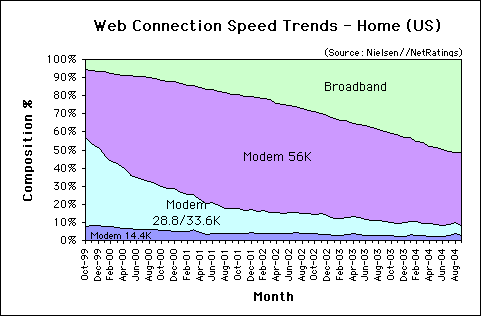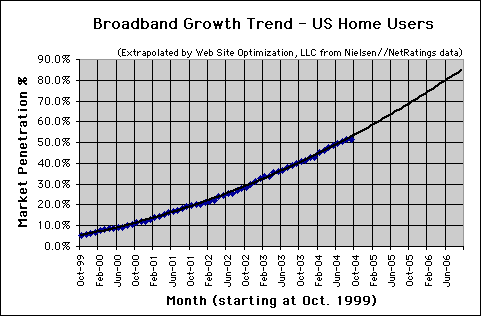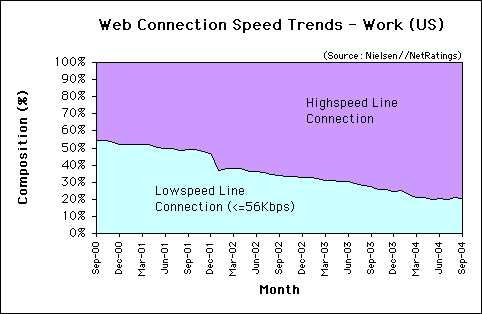For the first time, U.S. broadband penetration dropped to 51.3% among active Internet users in September. US broadband penetration decreased by 0.09 percentage points in September, with 51.33% of active Internet users on high-speed connections at home. 48.67% of US home users dial into the Internet with “narrowband” connections of 56Kbps or less. Meanwhile the FCC Thursday approved rules allowing broadband over power lines and eased restrictions on local phone companies’ high-speed networks.
The charts below, derived from Nielsen//NetRatings data, show trends in connection speeds to the Internet for United States users.*
Home Connectivity in the US
In September 2004, most active Internet users connect from home with broadband connections. Among narrowband users, 40.31% use 56Kbps modems, 5.69% use 28/33.3Kbps, and 2.67% use 14.4Kbps modems. In total, 48.67% of home users in the US connect to the Internet at 56Kbps or less (see Figure 1).
Web Connection Speed Trends – Home Users (US)
Figure 1: Web Connection Speed Trends – Home Users (US)
Source: Nielsen//NetRatings
Broadband Growth in the US
Broadband penetration in the US decreased by 0.09 points to 51.33% in September, down from 51.42% in August. This is the first time broadband penetration has decreased since we started tracking broadband penetration in October 1999. This decline is in marked contrast to the average increase in broadband of 1.04 points per month over the previous twelve months. Broadband share in the US should exceed 70% by November of 2005 (see Figure 2).
Broadband Connection Speed Trend – Home Users (US)
Figure 2: Broadband Connection Speed Trend – Home Users (US)
Extrapolated from Nielsen//NetRatings data
Work Connectivity
Most workers in the US enjoy high-speed connections to the Internet. Most use a high-speed line such as a T1 connection, and share bandwidth between computers connected to an Ethernet network. The speed of each connection decreases as more employees hook up to the LAN. As of September of 2004, of those connected to the Internet, 79.63% of US users at work enjoy a high-speed connection, up 0.57% percentage points from 79.06% in August. 20.37% connect from work at 56Kbps or less (see Figure 3).
Web Connection Speed Trends – Work Users (US)
Figure 3: Web Connection Speed Trends – Work Users (US)
Source: Nielsen//NetRatings
FCC Approves Broadband Over Power Line Rules
The Federal Communications Commission on Thursday eased restrictions in two areas of high-speed networking in the US. The FCC issued new rules governing broadband over power line (BPL) use paving the way for faster broadband adoption in the US. The FCC also eased restrictions on using the local high-speed networks of phone companies. FCC Commissioner Kevin Martin said:
“BPL systems use existing electric power lines to provide high-speed communications. Because power lines are ubiquitous – reaching virtually every community and every home – BPL systems have the potential to become a last-mile solution throughout the United States.”
Commissioner Michael Copps said:
“This is a market desperate for more competition. We all know by now that our country is now Number 11 in broadband penetration. That’s pretty hard to take.”
Further Reading
- FCC Adopts Rules for Broadband Over Power Lines to Increase Competition and Promote Broadband Service to All Americans. (PDF)
- FCC news release, Oct. 14, 2004
- FCC Removes More Roadblocks to Broadband Deployment in Residential Neighborhoods – Action Harmonizes Treatment of
Deep Fiber Networks. (PDF) - FCC news release, Oct. 14, 2004
- FCC eases high-speed network rules
- The Federal Communications Commission on Thursday made more of the local phone networks free from competition rules. News.com, Oct. 14, 2004
- FCC: Make Way for Speed Over Power
- In an effort to increase US broadband penetration, the FCC Thursday approved rules governing the use of broadband over power lines. The rules are designed to prevent interference from sensitive military and public safety installations, and radio stations. Internetnews.com, Oct. 14, 2004
- Nielsen//NetRatings
- Provides the US broadband data (percentage of active Internet users) for the Bandwidth Report.
*Note that Nielsen//NetRatings reports the percentage of active Internet users that use broadband from home, not broadband households. NetRatings uses a panel of 40,000 to 50,000 people with software meters installed on their computers. These meters detect connection speeds. Each month they do an enumeration study to call a number of people to calibrate the panel by adjusting weightings to match the population at large.
The Bandwidth Report is featured monthly on URLwire – news of useful and unique web content since 1994.



